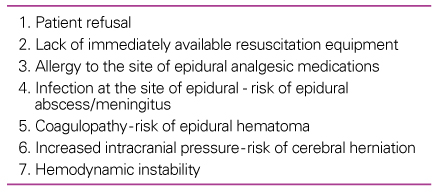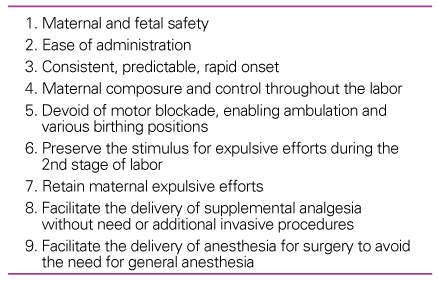 |
 |
- Search
| J Korean Med Assoc > Volume 53(1); 2010 > Article |
Abstract
We discuss recent advances in the administration of labor analgesia aimed at a more effective birthing experience for parturient women. Patient-controlled epidural analgesia (PCEA) is the most effective method of labor pain relief in medical practice. It also provides more consistent and predictable labor analgesia. When a parturient women has a contraindication to epidural analgesia, systemic analgesia techniques are provided as a guide to effective analgesia. PCEA of "low-dose" or "light mixtures" of local anesthetics and lipophilic opioids has allowed anesthesiologists to provide reasonable pain relief for most parturient women while decreasing the total dose of local anesthetics and opioids, thus minimizing the side effects of each agent. Fentanyl analgesia utilizing patient-controlled intravenous analgesia (PCIA), may provide effective self-titrated pain relief, although they are not as effective as the epidural method. Recently, remifentanil was suggested as the opioid of choice for labor analgesia. Potential advantages of remifentanil include better titration of analgesia and neonatal outcome. However, all systemic opioids rapidly cross the placenta. These drugs may cause neonatal respiratory and neurobehavioral depression. In order to reduce the incidence of breakthrough pain, more research on computer-integrated patient-controlled analgesia technology may be necessary. The study of a new local anesthetic drug that has less motor blockade and cardiotoxicity than ropivacaine is desirable, while PCEA is the most effective form of labor analgesia currently available. If epidural analgesia is contraindicated, PCI remifentanil bolus alone may be a suitable systemic analgesia for labor pain.
References
1. Hawkins JL, Gibbs CP, Orleans M, Martin-Salvaj G, Beaty B. Obstetric anesthesia work force survey, 1981 versus 1992. Anesthesiology 1997;87:135-143.
2. Wong CA. Labor analgesia. is there an ideal technique? Anesth Analg 2009;109:296-298.
3. Wilson MJ, Cooper G, MacArthur C, Shennan A. Randomized controlled trial comparing traditional with two "mobile" epidural techniques: anesthetic and analgesic efficacy. Anesthesiology 2002;97:1567-1575.
4. Chestnut DH, Owen CL, Bates JN, Ostman LG, Choi WW, Geiger MW. Continuous infusion epidural analgesia during labor: a randomized, double-blind comparison of 0.0625% bupivacaine/0.0002% fentanyl versus 0.125% bupivacaine. Anesthesiology 1988;68:754-759.
5. Sharma SK, Leveno KJ. Regional analgesia and progress of labor. Clin Obstet Gynecol 2003;46:633-645.
6. Halpern SH, Carvalho B. Patient-controlled epidural analgesia for labor. Anesth Analg 2009;108:921-928.
7. Wong CA, Ratliff JT, Sullivan JT, Scavone BM, Toledo P, McCarthy RJ. A randomized comparison of programmed intermittent epidural bolus with continuous epidural infusion for labor analgesia. Anesth Analg 2006;102:904-909.
8. Sia AT, Lim Y, Ocampo C. A comparison of a basal infusion with automated mandatory boluses in parturient-controlled epidural analgesia during labor. Anesth Analg 2007;104:673-678.
9. Howell CJ, Dean T, Lucking L, Dziedzic K, Jones PW, Johanson RB. Randomised study of long term outcome after epidural versus non-epidural analgesia during labour. BMJ 2002;325:357.
10. Rayburn WF, Smith CV, Parriott JE, Woods RE. Randomized comparison of meperidine and fentanyl during labor. Obstet Gynecol 1989;74:604-606.
11. Nikkola EM, Ekblad UU, Kero PO, Alihanka JJ, Salonen MA. Intravenous fentanyl PCA during labour. Can J Anaesth 1997;44:1248-1255.
12. Jordan S, Emery S, Bradshaw C, Watkins A, Friswell W. The impact of intrapartum analgesia on infant feeding. BJOG 2005;112:927-934.
13. Jones R, Pegrum A, Stacey RG. Patient-controlled analgesia using remifentanil in the parturient with thrombocytopaenia. Anaesthesia 1999;54:461-465.
14. Thurlow JA, Waterhouse P. Patient-controlled analgesia in labour using remifentanil in two parturients with platelet abnormalities. Br J Anaesth 2000;84:411-413.
15. Olufolabi AJ, Booth JV, Wakeling HG, Glass PS, Penning DH, Reynolds JD. A preliminary investigation of remifentanil as a labor analgesic. Anesth Analg 2000;91:606-608.
16. Blair JM, Dobson GT, Hill DA, McCracken GR, Fee JP. Patient controlled analgesia for labour: a comparison of remifentanil with pethidine. Anaesthesia 2005;60:22-27.
17. Volikas I, Butwick A, Wilkinson C, Pleming A, Nicholson G. Maternal and neonatal side-effects of remifentanil patient-controlled analgesia in labour. Br J Anaesth 2005;95:504-509.
- TOOLS
-
METRICS

-
- 0 Crossref
- Scopus
- 1,244 View
- 6 Download
-
Related articles in
J Korean Med Assoc -
Lower Abdominal Pain1999 August;42(8)









